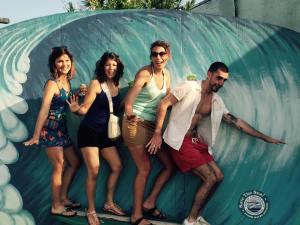Against a deep black sky, a perfectly halved moon illuminated our small campsite set within the welcoming confines of a scrubby circle of tall grasses and short trees. Nearby, a tributary flowing down into Flat Laurel Creek gurgled the sound of its boundary.
We arrived at our home for the evening before nightfall, when the sun was just releasing its hold on the day. We’d hiked since noon, eating a picnic lunch on the crest of Tennant Mountain, right below the plaque that marks its peak. We hiked over wet and rocky trails where blobs of clear eggs, punctuated by the promise of new frog life, bobbed in pools and puddles. The only other real wildlife we saw was a pack of undergrad males on their spring break, all having reunited in Pisgah Forest from their various schools.

I hadn’t been back in the mountains, like really back in them, since I moved away from AVL in August. I was afraid to return sooner – afraid that if I didn’t separate myself enough and bond with the land and people in the Piedmont that I’d just live in the mountains in my mind instead of in the world all around me. But coming back home on this trip to Black Balsam and Sam’s Knob felt solid. My friend from school, my backpacking buddy two trips in a row now, couldn’t stop commenting on just how perfect everything was. That’s a heavy word and yet she was so right. You know those moments when you have an awareness of how totally happy and satisfied you are at the time? The whole trip was like that for both of us (I’m willing to say from our continual debriefing). And I was aware, maybe because we’d spent the previous week running from classroom to computer to meetings to google hangouts, that it was so perfect because we had so much less. So much less stimulation, so many fewer options, so many less modes of communication.
And yet I felt more connected.
Laying under the stars, dreaming of life thousands of years ago, my mind was at peace.
It was a good break for my mind all the way around. Only reflecting back now, since this is a blog about life with diabetes, do I realize that thoughts about diabetes don’t dominate any aspect of the trip (except one, and I’ll get there). Of course I thought about diabetes the whole time, as a backdrop to everything else, but I didn’t notice so much that I was thinking about it. It didn’t frustrate me to be thinking about it and I didn’t worry about it. When I reached a level of competency with diabetes I assumed that I had grown with it as far as I would. I had learned that diabetes was in fact manageable but thought that it would never get easier. And that is true; the actual management and burden of diabetes doesn’t necessarily get easier in and of itself, although it does change. But it’s sort of like (I would imagine) a marathon runner training for something and then experiencing a level of ease with certain aspects of it. Yes the last couple miles, or shaving speed, or steep courses, are still a challenge, but there is a certain level of ease with running a distance that to me, a non-runner, seems insurmountable.
Ok, so I mentioned that one aspect of the trip when diabetes did announce itself loudly: the great Bear vs. Nightime-Low debate. If you’re a person with T1d you understand that you can’t go to sleep without knowing where the food is in the house. For me, I keep a honey bear right by my bed. But when I’m backpacking, my goal is to keep bears far, far away from my bed. So what to do?
And I really don’t know. What we did was secure and hang our food appropriately, far, far away from our campsite. One of the recent times that I went backpacking I had to tear the bear bag down from a tree in the middle of the night to get to more carbohydrates, and I just wasn’t prepared to do that again, so I decided to keep two honey zinger packets in the tent.
Sure enough I woke up in the middle of the night with a serious low. I’m not proud of these backpacking lows and I’m still trying to work them out. Walking all day with an extra 30-50 lbs. on my back exhausts my muscles in an unusual way. Even if I got to bed at 175 mg/dl, with very little insulin on board, I could wake up in the 30’s, like I did on this trip. Luckily I had the zingers. This time I stored them in my empty nalgene, which I thought, with it’s good seal, thick plastic, and odor of aquamura, would deter a bear as well as anything else I had. A pelican case could be another option.
So here’s the part where I need some diabexpertise: what do people with T1d who backpack do when they’re camping, say out West, where the stakes involve grizzlies? What do you do here in the East? I really appreciate your comments and dialogue!











